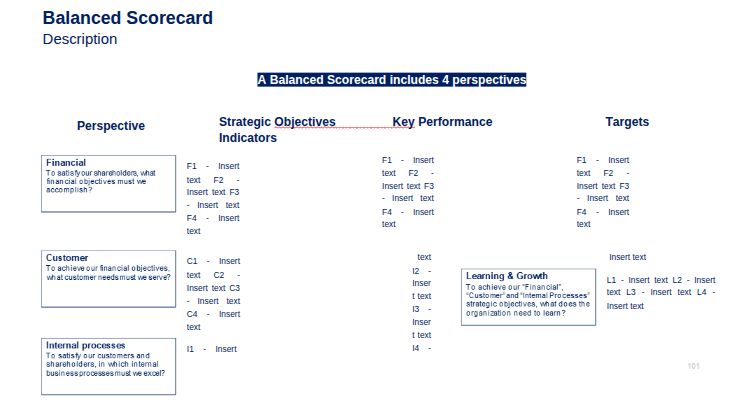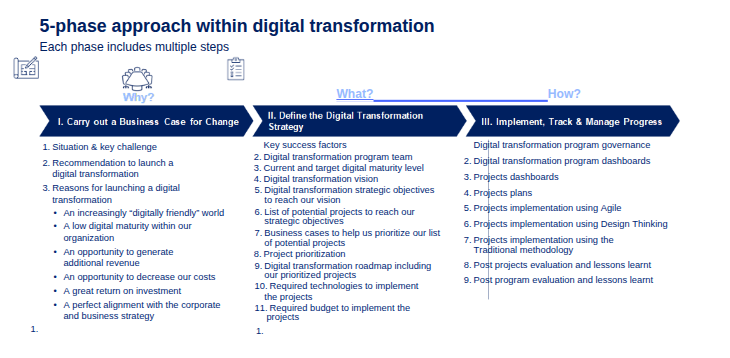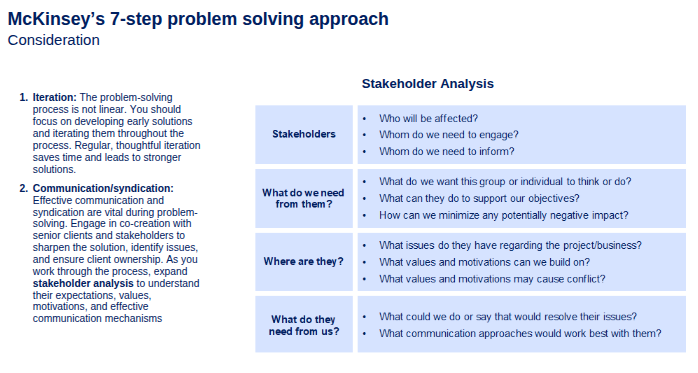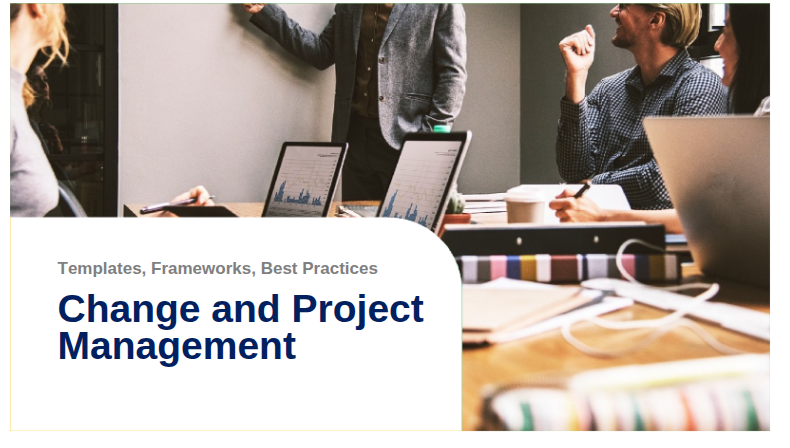
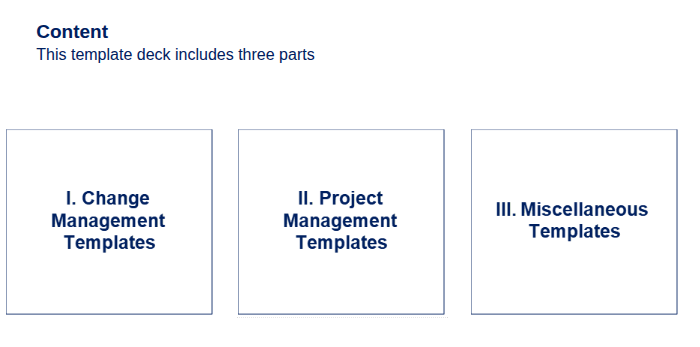
How to create an effective change management process?
Regardless of the desired change or the model you are using, here are some guidelines to follow when developing the process to ensure maximum success.
- Identify the desired change and goals. You can’t create an effective change without knowing what you are working toward. The first step is to plan your change (as mentioned above) and, most importantly, identify your goals for implementing a change. Keep this in mind as you work through the rest of your change management process.
- Involve key stakeholders and present the business case. To implement a change management process, you need the buy-in of important people, such as management and the C-suite. Create a business case, or a document, explaining the importance of a project through a cost-benefit analysis, which will help overcome any resistance to your proposed change. A business case can also help you articulate the challenges and benefits of the proposed change.
- Determine resources and measurements of success. Part of planning your change management process is creating a detailed road map for how the execution will go. That includes identifying any resources you need, from human to technological to financial, and ensuring you have them on hand. During this step, you should also identify KPIs and milestones that will help you know your project is on the right track.
- Provide clear communication from start to finish. People don’t like feeling as if they are out of control or that decisions are made for them. Make sure that you are communicating directly with people and treating them as equal partners in the transition. During your planning, outline how and when you will communicate with people, because it’s easy to forget during intense work.
- Manage resistance and improve the impact of the change. Resistance is inevitable when change occurs. With preparation, you can manage resistance and ensure that it won’t be disruptive. Plus, resistance can be helpful because other members of your organization could have feedback on how to improve the change.
- Recognize the change management project’s success. This seems like a frivolous component of change management, but recognizing and celebrating success is an important part of the change! People will put in a lot of effort to implement your project, and they will want to know if their work paid off and to have that effort acknowledged. Celebrate the success of your final change and recognize the fulfillment of milestones along the way.
- Review impact and improve your change management process for the future. After you implement your change, check in with the data you gathered along the way and with your team to see how the change has impacted them. Is there a way the transition could have been smoother? Use this knowledge to prepare for any future transitions.
Description of the Kotter’s 8 step model of change

The Model walks you through the process of initiating, managing, and sustaining change in three phases
I. Change management approach
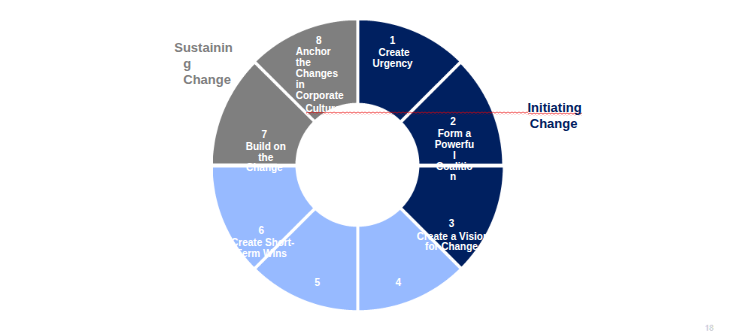
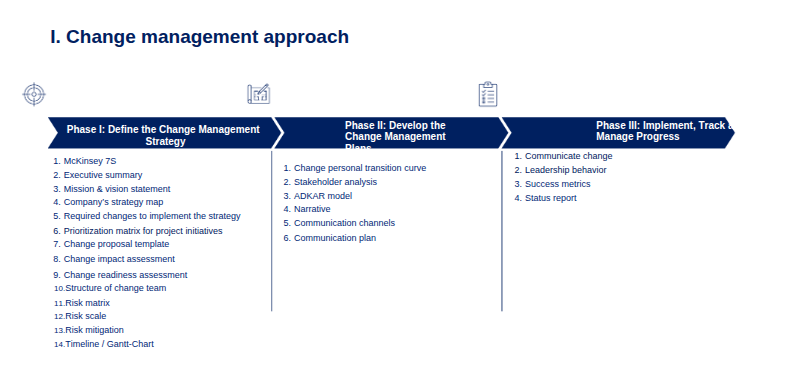
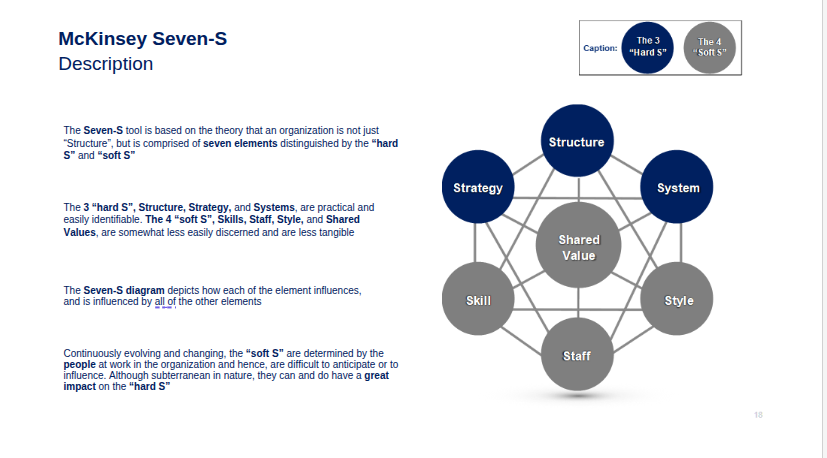
Change management strategy
The strategy describes who the impacted stakeholders will be and how the change will impact them, whether it be a small workgroup or organization wide. Capturing and reporting on these unique characteristics will help to inform change management plan and activities.
The change management strategy template helps the change leader to:
- Describe the change
- Define the impacted stakeholder groups
- Identify tactics to consider minimizing the impact the change may have on those impacted
- Capture perceived benefits for the change, which will then inform key messages and communications planning activities.
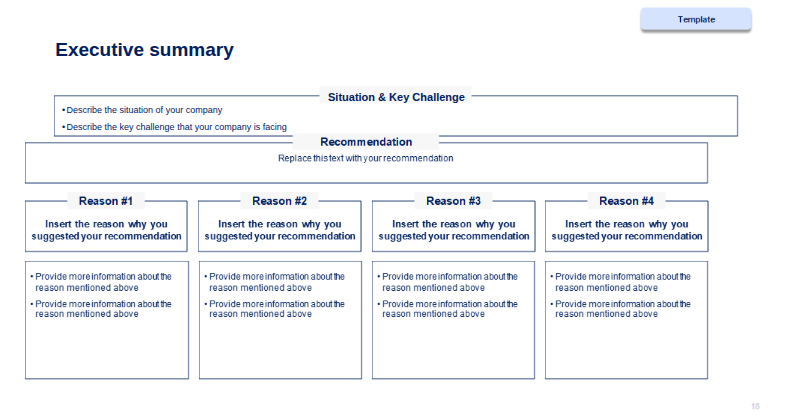
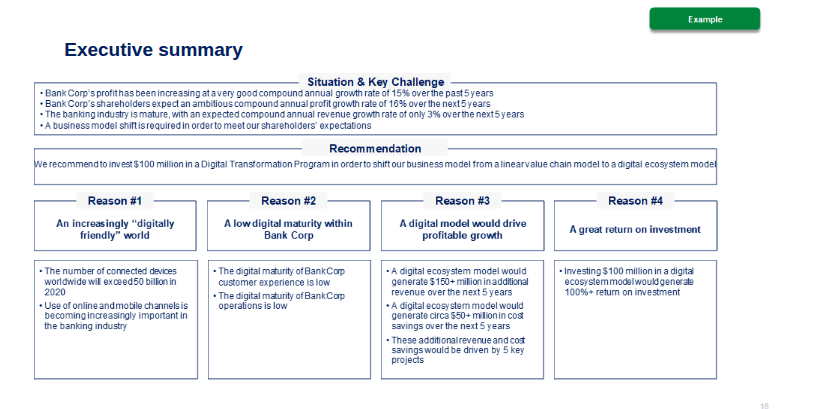
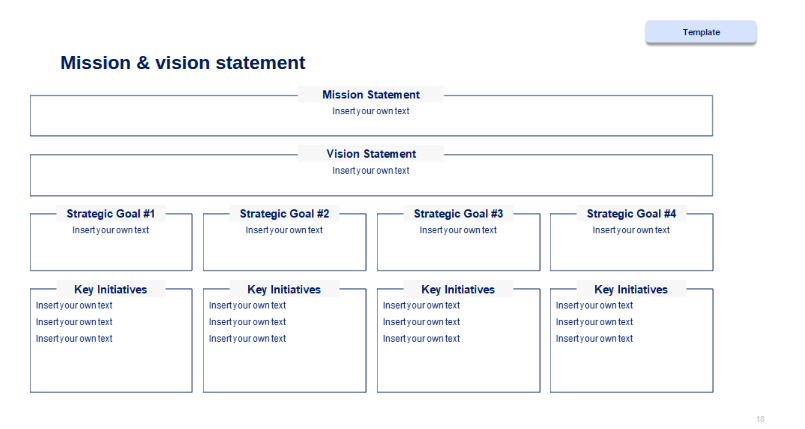
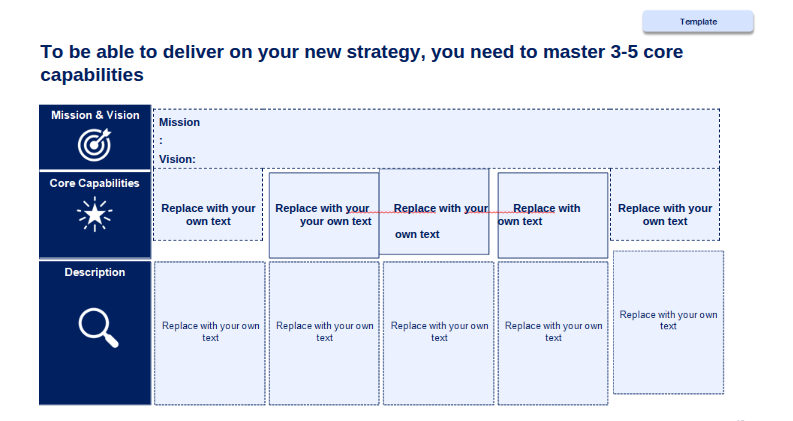
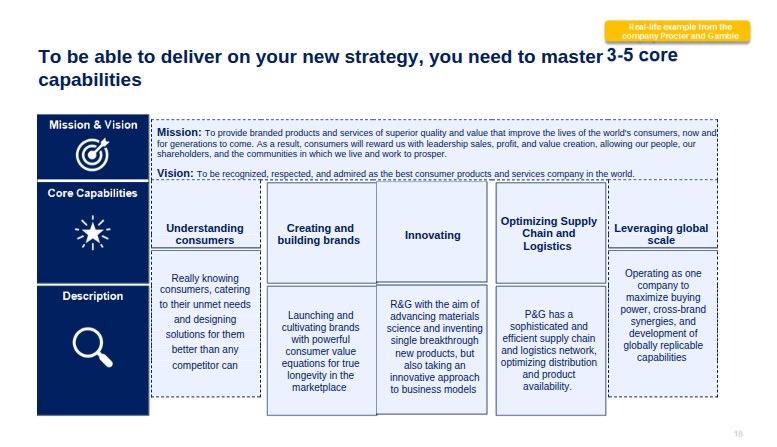
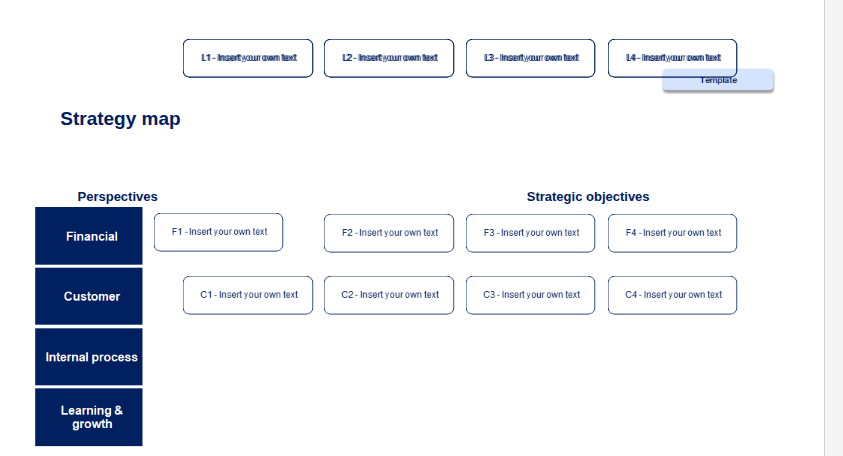
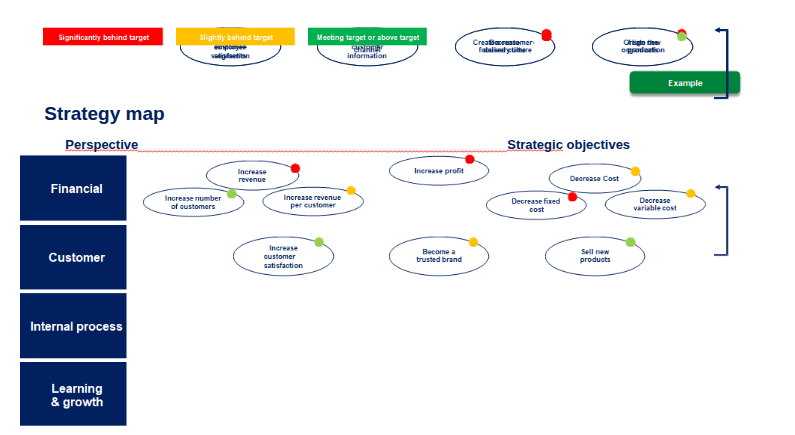
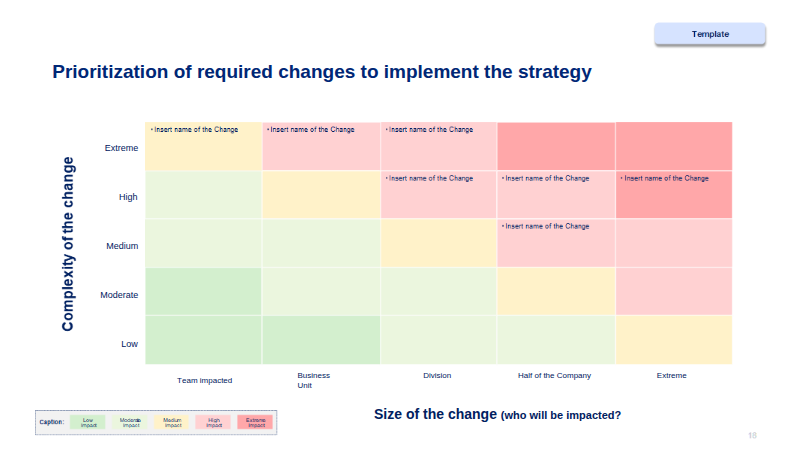
Change proposal
Before making the plans needed to roll out a change, make sure you understand why the change is needed. The motive behind or the reason for the change will influence every step of your planning process.
Getting started with a change proposal template, regardless of whether or not the change has already been approved, will force you to really dig into the ‘why’ behind the change. Once you’ve completed this template, you’ll be ready to justify the change and help others understand it as well.
This change management plan example also includes a section for potential benefits and potential negatives. Use this section to show your thought process behind the change. Share your own concerns while still rationalizing the need for the change by showing the benefits. Of course, no change can be 100% positive, but this section shows that you have considered the pros and cons and still believe the change is necessary.
Once you know why the change needs to happen, it’s time to designate change leaders who will help support the change.
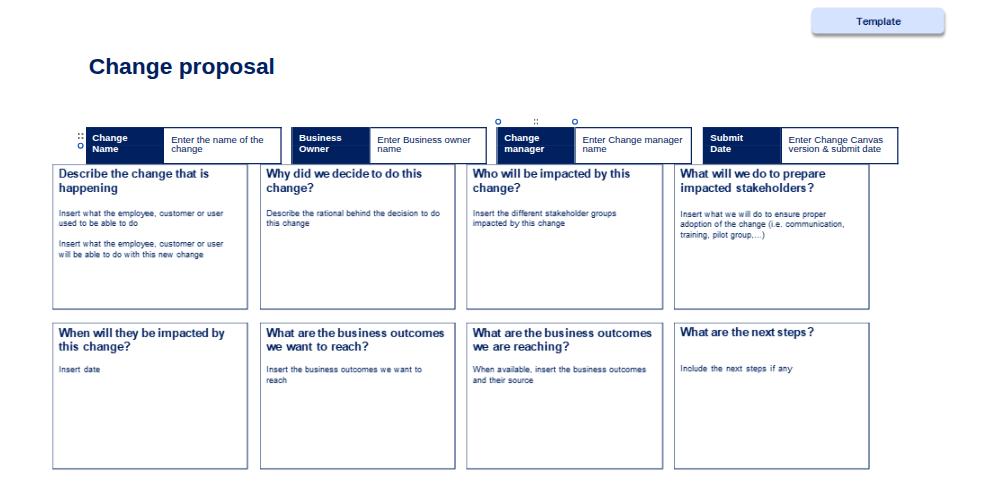
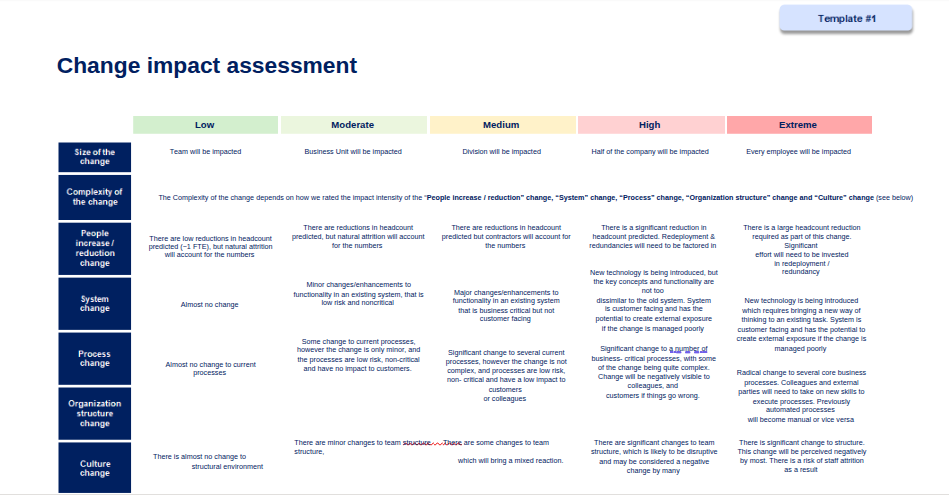
Change impact assessment
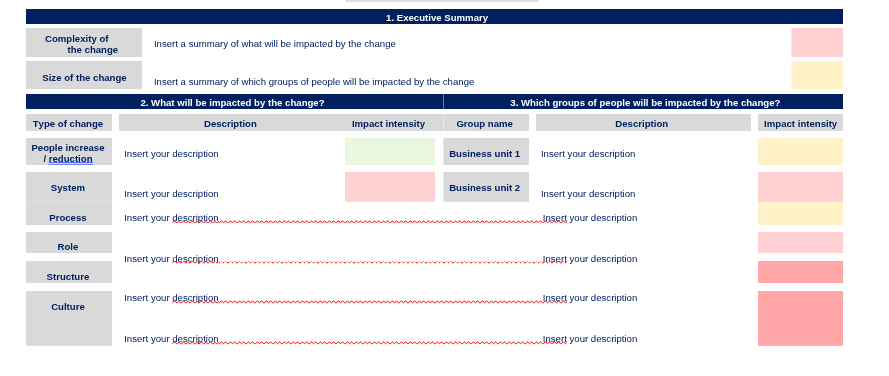
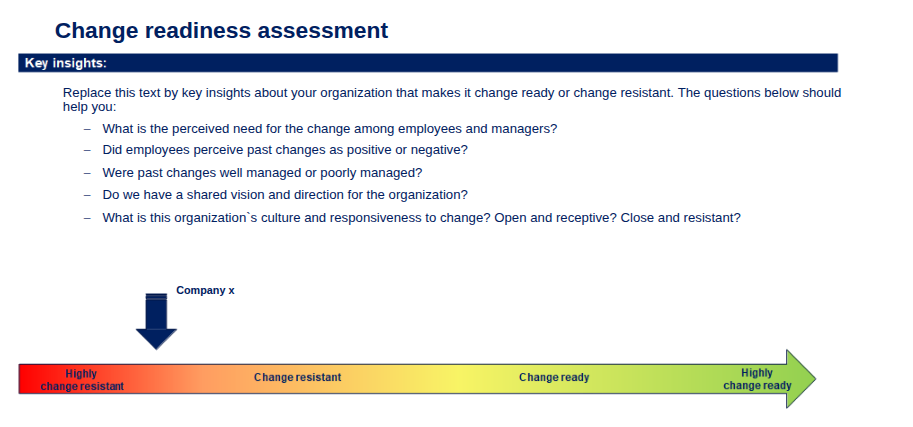

Overview change management team

Risk assessment
The purpose of risk assessment is to identify potential problems before they occur. This is to ensure risk mitigation activities can be planned and implemented as needed across the lifecycle of the change initiative. Use the following Risk Assessment Template to identify and address any issues that may hinder the projects desired outcomes.
How to use the Risk Assessment Template:
- List and describe the risk associated with the change initiative
- Indicate the risk category:
- Compliance – Adheres to laws, regulations, and policies
- Efficiency – Proficiently achieving the objectives of the process
- Financial – Efficient stewardship of funds
- Health & Safety – Promotes a healthy community and safe working environment
- Information – Supports accuracy and reliability of data
- Operational – Productive use of resources
- Reputational – Impacts university’s brand
- Security – Protect and secure information to prevent exploitation, corruption, or loss of data o Strategic – Supports a campus, unit, or collaboration level objective.
- Use the below Risk Assessment Matrix to identify the appropriate risk approach.
Types and scope of risks

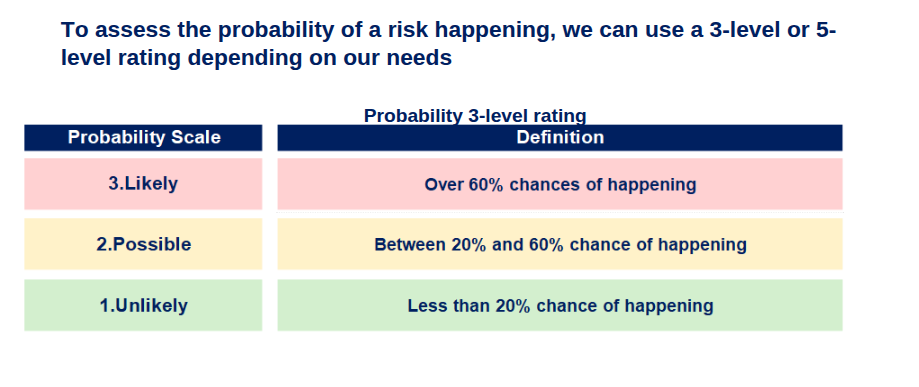
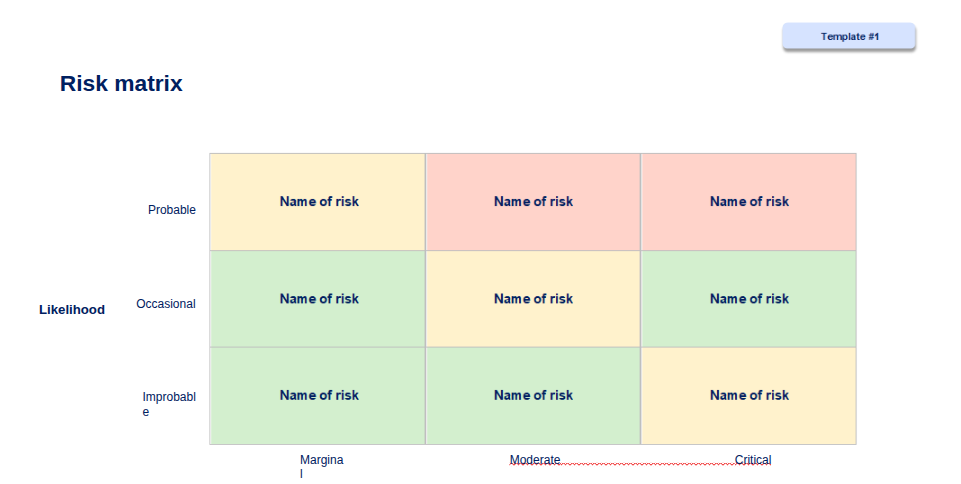

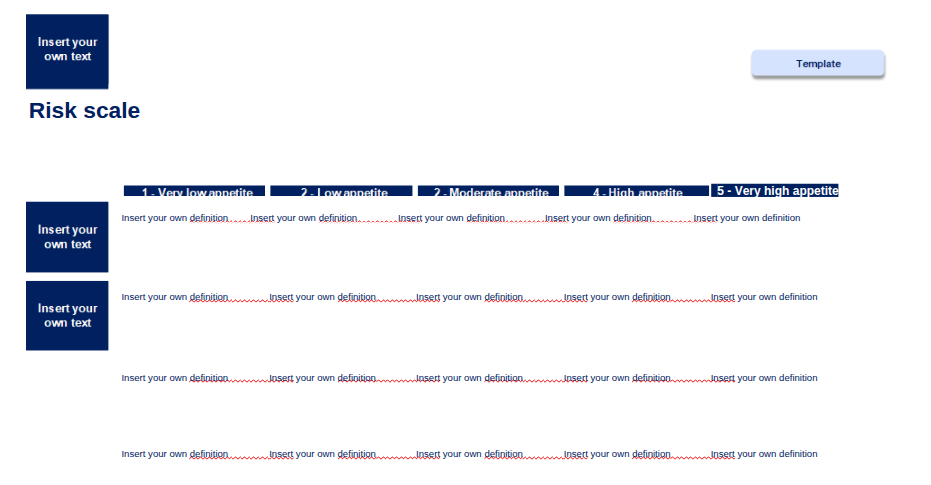
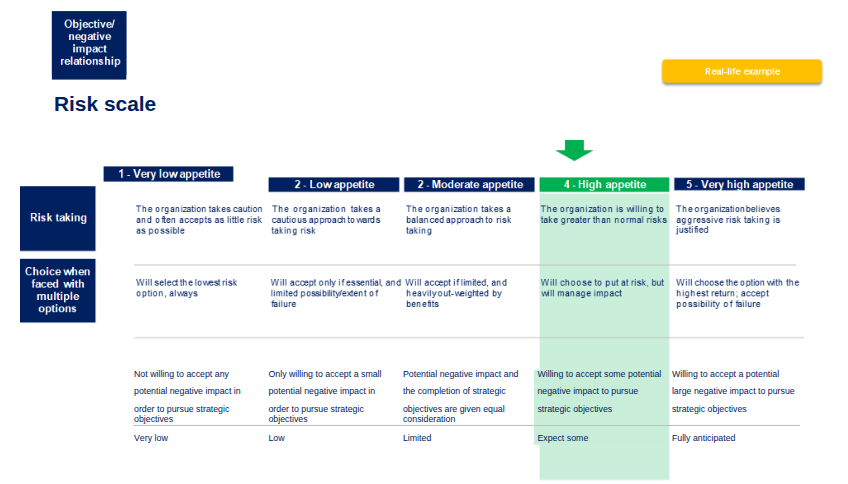
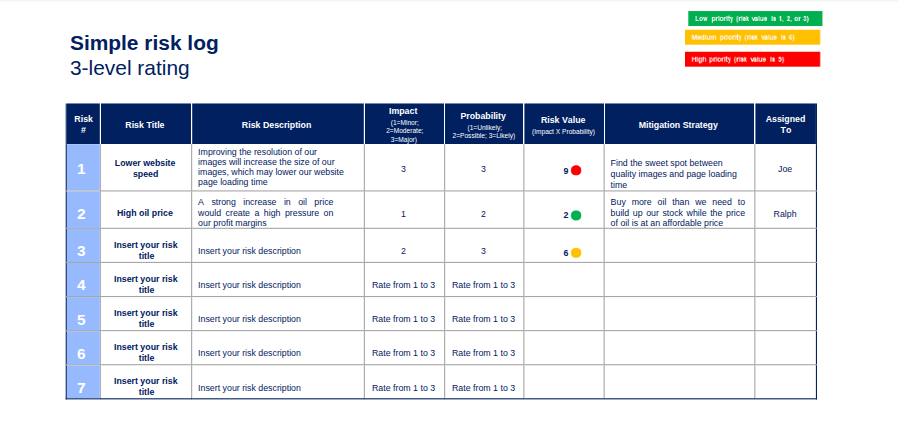
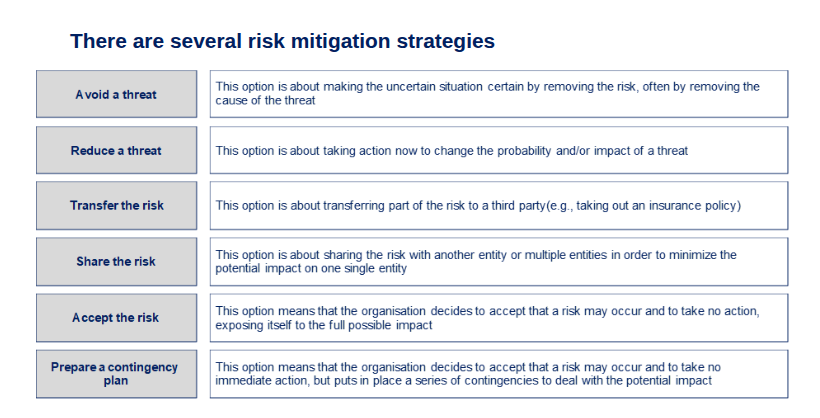
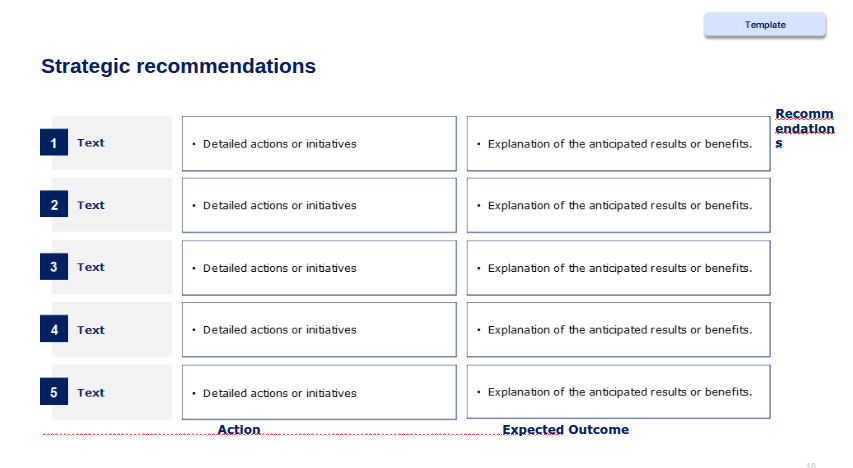
Change implementation strategies
When implementing change there are three strategies to consider: Pilot, Big Bang, or Phased Big Bang.
- Pilot: Choose a Pilot implementation, if you are testing a new innovative idea, possible growth strategy, or very risky core business operation. By implementing a pilot this will help the project team to analyze results, determine ROI and identify areas of risk and/or improvement before a full implementation roll-out. Ultimately, the reason for pilot testing is to test quickly and iterate as necessary.
- Big Bang: Choose a Big Bang implementation for initiatives that align to strategic business priorities driven from the highest levels of leadership. A Big Bang is best used for rolling out a new system or strategy that requires campus-wide adoption and is effective immediately. The implementation typically occurs all at once, and mass communications are used to update and inform employees.
- Phased Big Bang: A Phased Big Bang approach is used to chunk the implementation roll-out into cohorts. This approach aims to reduce operational risks associated with ramp up time or scalability and gives the project team the opportunity to iron out any difficulties identified. Groups who are selected for the first cohort must be willing to provide necessary feedback and be strong adopters of the strategy. As each new cohort rolls-out, implementation is expected to get easier as it gains more positive employee traction.
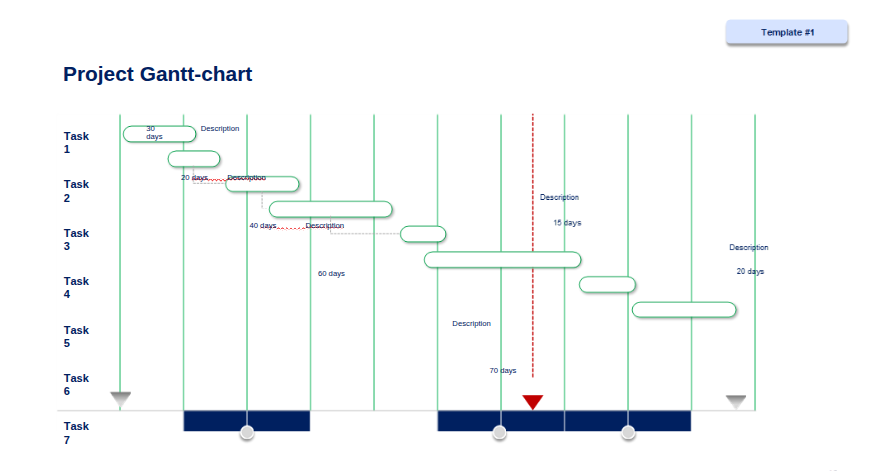
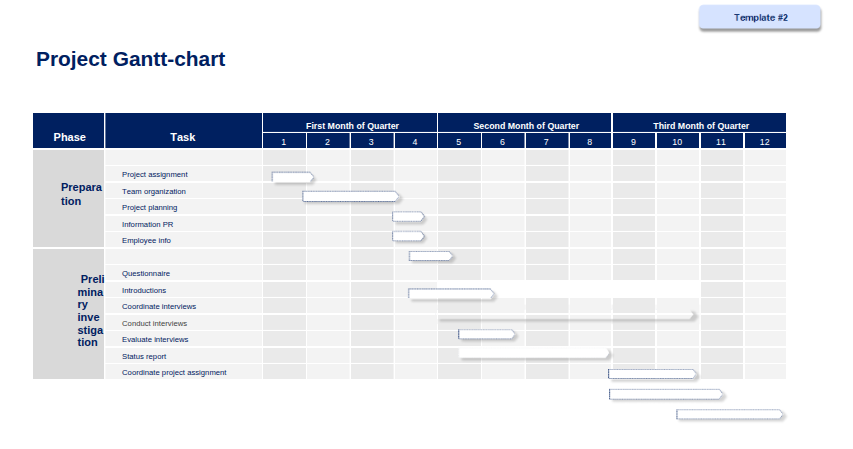
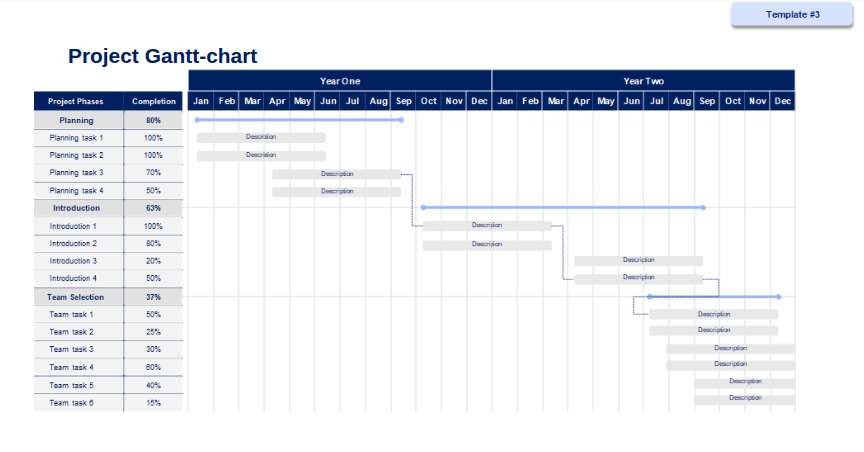
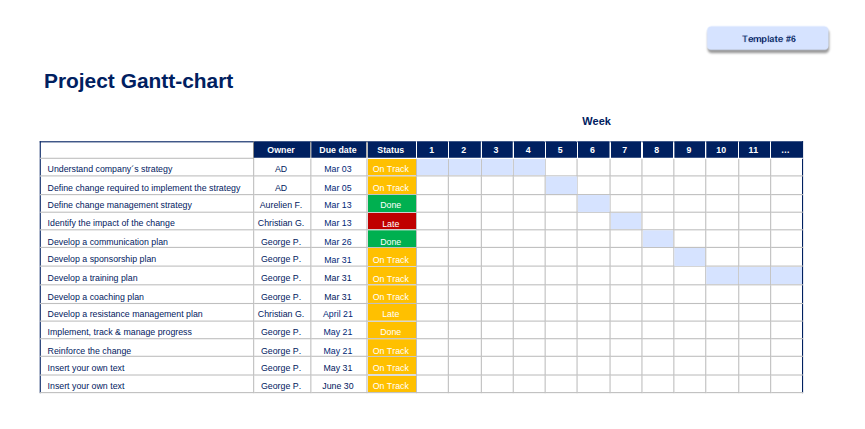


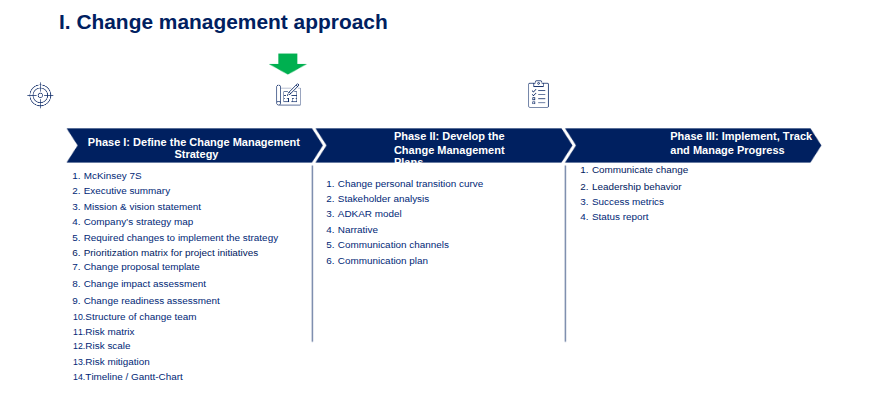
How do people react in case of change?
Change is about losing something of value, familiarity and comfort. The Change Curve will help you understand how people react to change, so that you can help them make their own personal transitions and make sure that they have the help and support they need.
We all react differently when impacted by change, some take longer than others to work through it, and some don’t experience the depth of the curve as deeply as others.
As a leader and colleague, it helps to understand how people will react to change, so that you can help and support them while they transition through the Change Curve from “Denial” to “Commitment”.
Based on the change curve, the higher the impact the more likely your team will experience the change more deeply.
You may notice however, some of your new team members may be “early adopters” and get on board with change really quickly. Discovering where your team members are at in their personal transition, and meeting them there, is a perfect start to your role of helping and supporting others.
Around 80 percent of the factors relevant to success in change management lie at a hidden level of the corporate culture
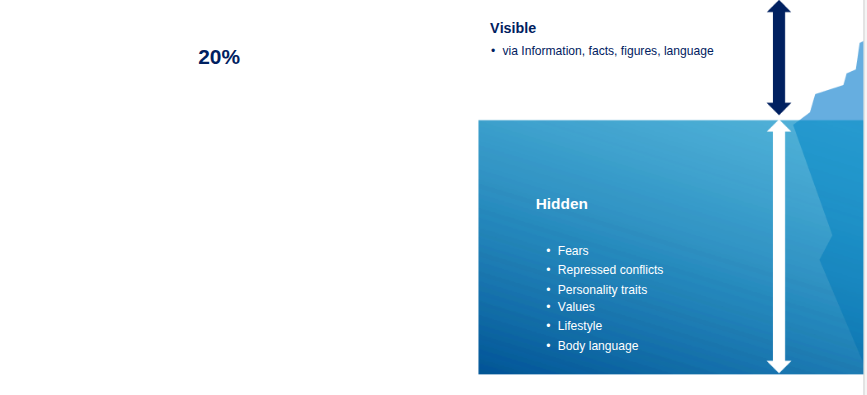
Change process model according to Kubler-Ross
Another way to understand change is Elizabeth Kubler-Ross’ Grief Cycle Model (1969). This model, originally used to explain an individual’s bereavement change journey, is also widely used to explain the emotional responses people experience during other forms of change.
The model identifies an individual’s emotional journey over time. As a leader, you must support people differently at each of the different emotional stages: Denial, resistance, exploration and acceptance.
While the journey appears sequential, in real life people move through the stages at different rates. Some individuals go through the stages in a rather linear fashion. They seem to zip right though the resistance parts of the journey, moving rather quickly straight to acceptance.
Others may get stuck for a period of time at a particular stage. They have trouble “letting go” causing them to get stalled along the way.
When multiple changes are staggered or simultaneously occur in an organization during a short period of time, it is not uncommon for an individual to revert back to an earlier stage as the next wave of change hits.
Interestingly, all individuals tend to go through the same emotional journey whether they perceive the change as a positive (something they’ve chosen) or as a negative (something that has been thrust upon them). People often wish they could skip the resistance part of the journey; they can’t. They must go through each of the stages in order to let go of the past and move forward into the future.
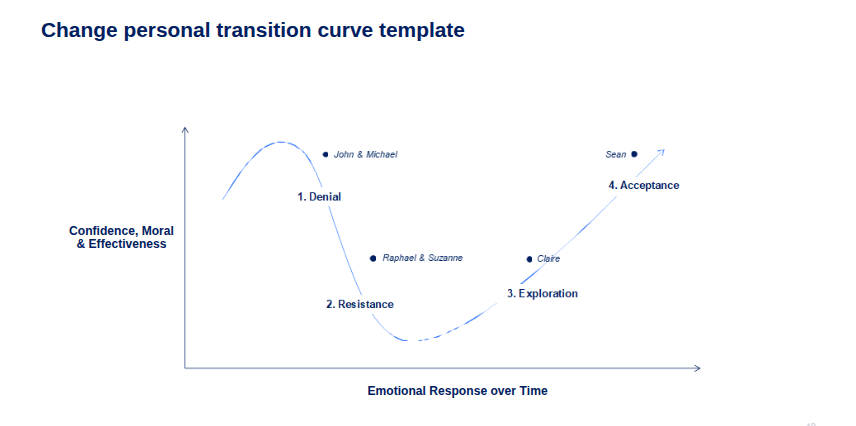
Stakeholder analysis
What is a stakeholder?
A stakeholder is a person who has a vested interest in something and who is impacted by and cares about how it turns out.
Potential stakeholders:
- People who can exert influence or pressure on your change
- People responsible for creating your change
- People who can choose to use or not use the results of your change
- People who will ultimately benefit from the work of your change.
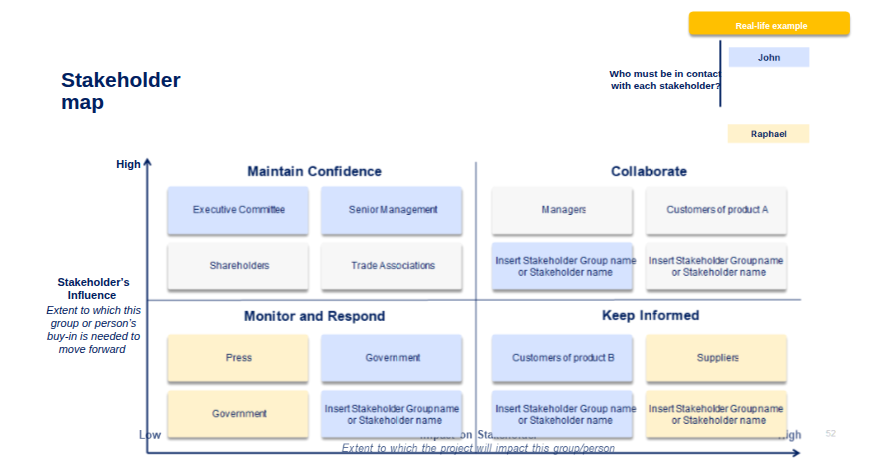
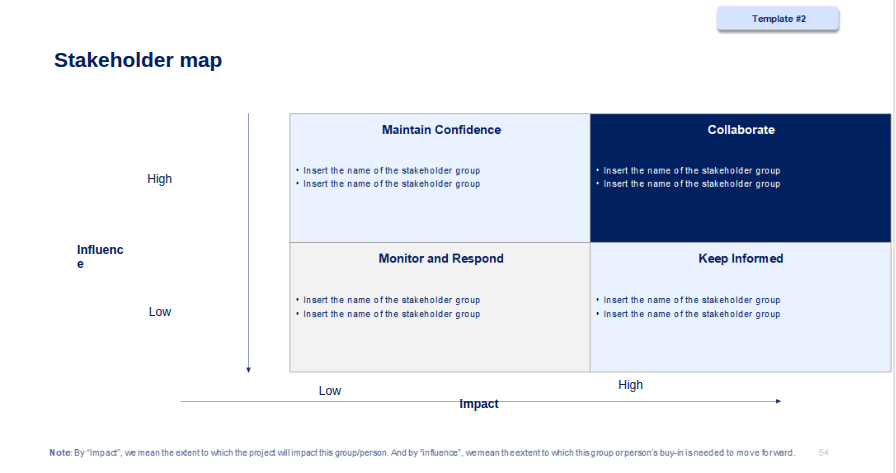
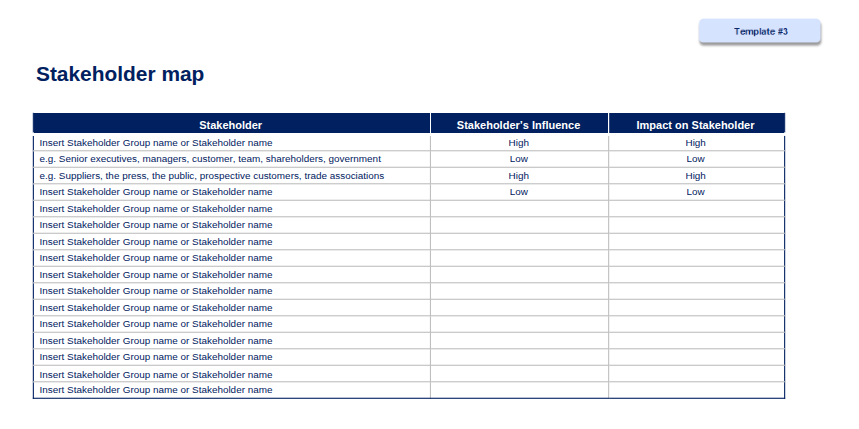
ADKAR model
Purpose
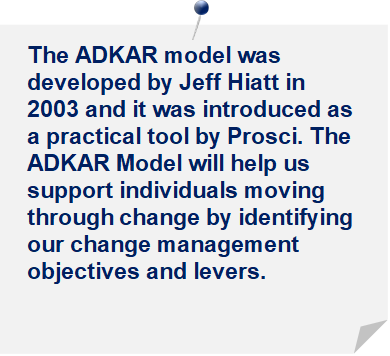
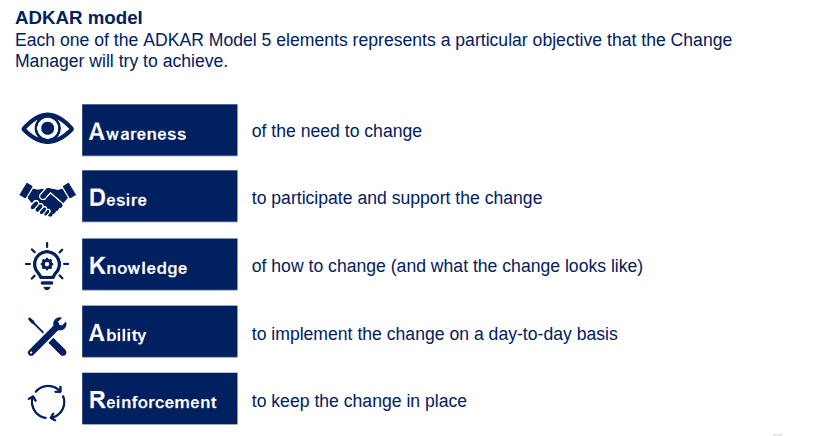
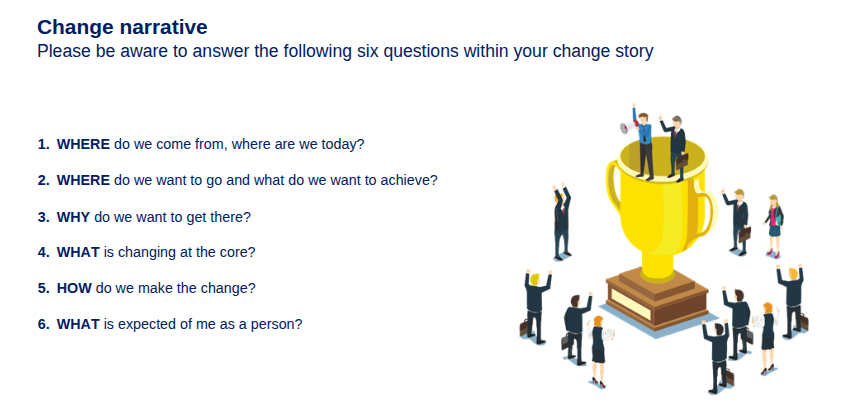
Defining the key messages define and communicate the narrative
- The current situation and the rationale for the change
- Business issues or drivers that created the need for change
- Competitive issues or changes in the marketplace
- Customer issues
- Financial issues
- What might happen if a change is not made
- A vision of the organization after the change takes place
- Scope of the change (including process scope, organizational scope, systems and technology scope)
- Objectives for the change (what does success look like)
- Overall time frame to implement the change
- Alignment of the change with the business strategy
- How big the change is needed (how big is the gap between today and the future state)
- Who is most impacted and who is least impacted
- The basics of what is changing, how it will change and when it will change, including what will not change
- The impact of the change on the day-to-day activities of each employee
- “What’s in it for me” (WIIFM) from the employee’s perspective
- Implications of the change on job security
- Specific behaviors and activities expected from the employee, including support of the change
- Procedures for getting help and assistance during the change
- Ways to provide feedback
- The expectation that change will happen and is not a choice
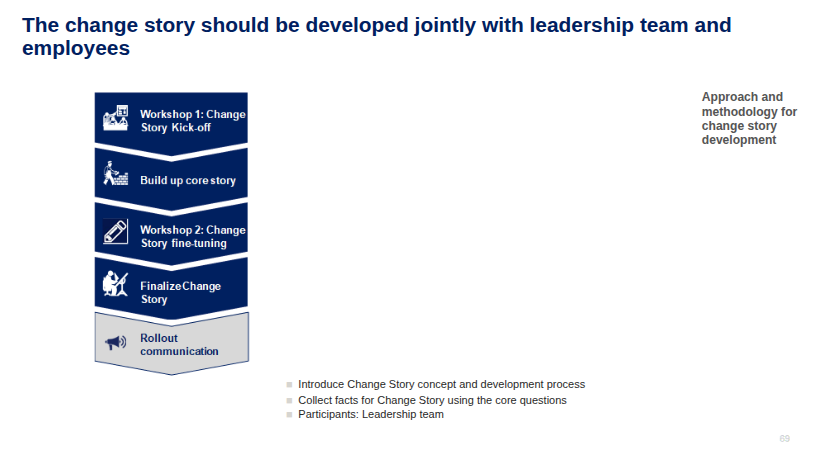

- Prepare collected facts
- Develop change story draft
- Participants: Project core team
- Test facts and fine-tune Change Story
- Develop ideas for visualization with creative techniques
- Participants: Leadership team, change facilitator and employees
- Fine-tune and align Change Story
- Visualize Change Story
- Participants: Project core team (optional: creative agency )
- Test Change Story and incorporate feedback
- Adapt Change Story for different target groups if necessary
- Communicate Change Story to identified Stakeholders
Communication channels (1/2)
The channel matrix below will give us a comprehensive list of the key communication channels to consider, from face-to-face meetings to newsletters.
- Group meetings
- Focus groups
- One-on-one meetings
- Road show presentations (by project team)
- Town Hall meetings
- Team meetings
- Brown bag lunches
- Training courses and workshops
- Emails
- Bulletin boards
- Cafeteria postings
- Change booklets
- Corporate newsletters (feature section)
- Demonstrations
- Frequently asked questions (memos or newsletter feature)
- Internal memos
- Intranet pop-ups
- Marketplace changes
- Customer input
- Ready-access to information
- Employee rumors
- Leaflets
- Posters
- Project newsletters
- Videos
- Voicemails
- Webcasts
- Website (Intranet)
- Word of mouth
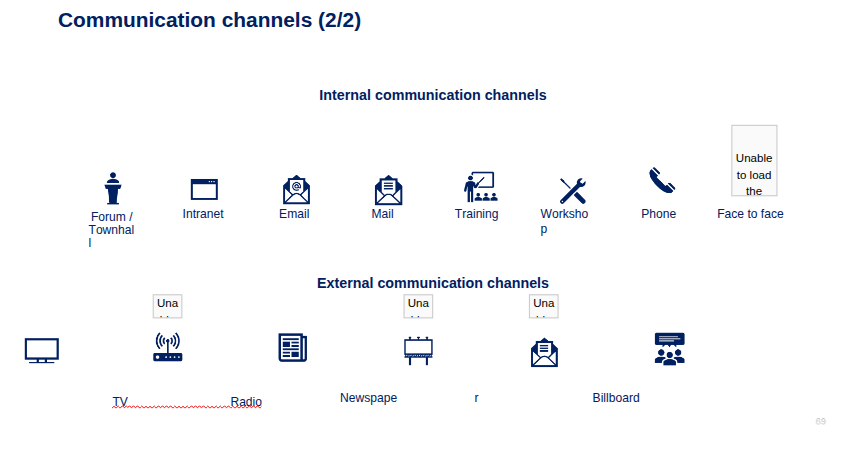
Communication plan
A project communication plan is a document that explains how project stakeholders will share information with each other. A project communication plan should include:
- A list of project team members or key stakeholders
- The type of information you will share, and with which team members
- Communication methods, including scenarios for when to use each method
- Frequency of communication
- Contact information for every team member.
Clear and consistent communiaction is the key to any change management plan. When you take a strategic approach to communications, you’re doing a lot to keep people focused and foster a sense of trust. You aren’t working in the dark or trying to hide your progress; you’re striving to be visible and accessible every step of the way.
The communication plan serves two purposes:
- It provides the change leader with a framework to define the change management strategy and the change management communications plan.
- In addition, the document provides the reader with a clear picture of the change, the steps that will be taken to increase project success, the potential cost of the project along with the timelines for implementation.
Communication plan
Keep in mind as you are communication that people have a limited capacity to absorb information under stress, This is why you simply cannot communicate too much.
Best Practices for Communication:
- Communicate often
- Support the change with a positive, yet realistic attitude
- Do raise concerns to the level above you
- Don’t criticize the proposed change to the level below you.
- Be concise/consistent/use simple language
- Be honest about what is/is not known
- Show caring and empathy
- Listen more than talk, acknowledge feelings
- Be aware of tone, e.g. pronouns (“we” NOT “you”)
- Provide opportunity for dialog, ask for input and feedback (to ensure commitment to the proposed change)
- Ask… “What additional information do you need?”
- Ask… “How can we best set you up for success?”






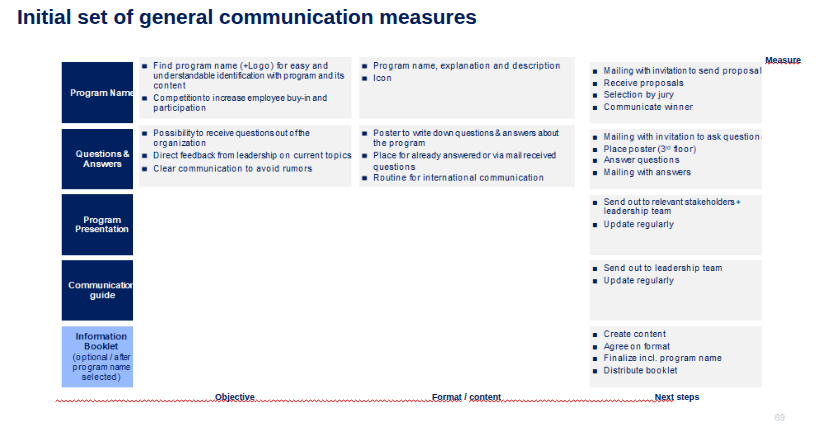
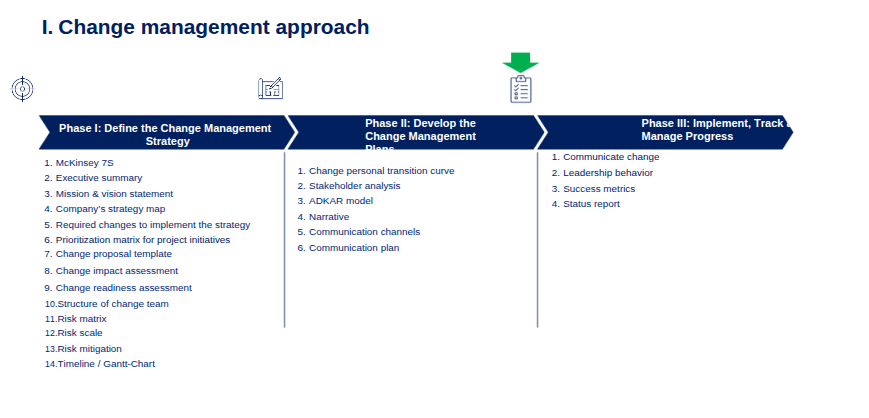

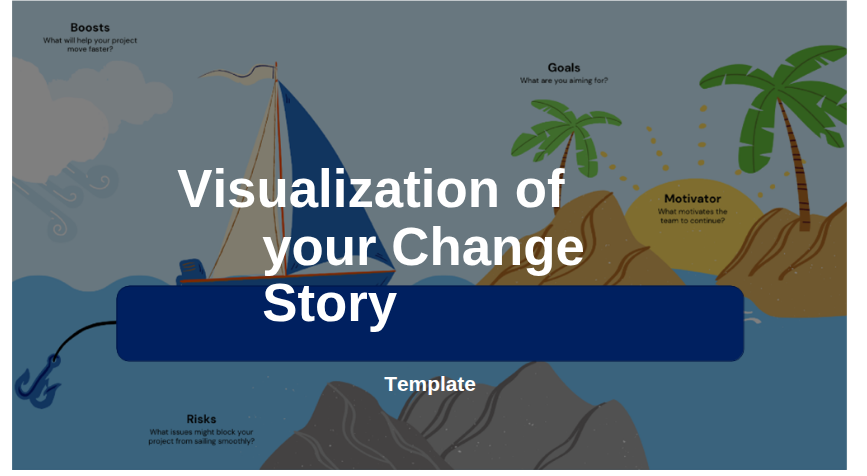
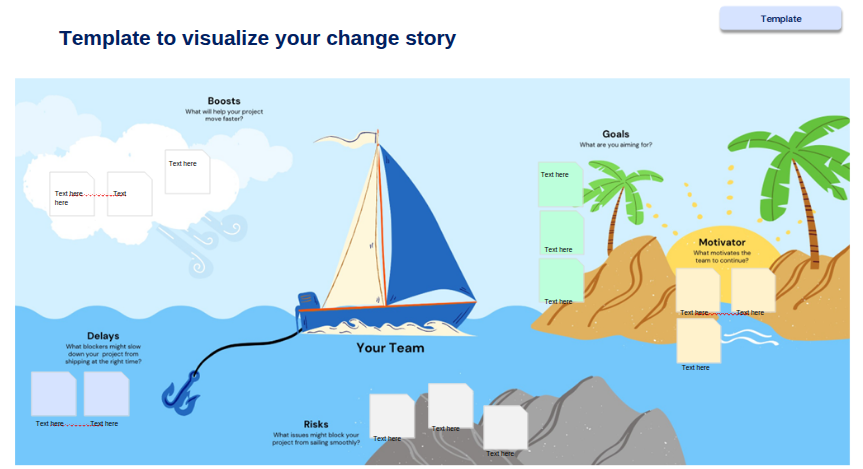
Leadership behavior is a key success-factor for a change initiative
Ensure top management transparency; if you want your employees to be transparent, cultivate a culture of transparency by being transparent; ask your management for feedback
Show ownership and honest commitment for the program
Take fears away what the program will do to the organization; define a clear and positive vision on this journey
Best practices for leading change (1/3)
- Provide information, what you know, what you don’t, when to expect updates: Employees need all available information to make realistic assessments and effective plans. Share what information you have when you have it: what is changing, what is not, what is known, what is unknown, when to expect updates.
- Display a positive attitude: As the leader, you are in a positon of great influence. In a sense you are your team’s North Star. Even if you are not yet fully onboard with the change, display to your team an attitude that is unbiased and welcoming of feedback.
- Stay connected to your team: Focus on team goals, foster support, monitor functioning, and celebrate achievements. Re-recruit people –
Reiterate to each team member their value, and your desire to have them remain on the team and support the change.
- Surface issues and concerns: Show empathy; help employees reframe their personal response to the change so they can effectively manage their own personal resistance
- Provide more structure: Define short-term objectives, time frames, priorities, and standards to help your team regain its equilibrium
- Protect quality and customer service: Service standards must remain high.
Delegate – Continue delegating work tasks while remaining mindful of each employee’s emotional stage and providing them relevant support.
- Empower: As appropriate, give employees more influence in day to day decisions. Determine the appropriate level of authority to assign by considering an employee’s current emotional stage, level of experience, capability, and the task itself.
- Raise the bar: Provide challenging assignments and coach employees to grow and develop their skills
- Inform/update higher management: Provide candid feedback on the change as it relates to the work and its impact on the people. This ensures leadership has the information needed to make informed decisions.
Best practices for leading change (2/3)
Practice the 4 Vs:
This is not a change strategy by itself, rather a piece of a larger strategy, or a tool, to use at the very moment the change goes live.
- Visibility – Be visible, available and interested in your employees during this time. Brief check-ins will leave employees feeling supported and valued.
- Variability – Allow for varying personal reactions (see Kubler-Ross grief cycle model, pages 17-19) and give employees more flexibility at work to take care of themselves.
- Ventilation – allow opportunities (both formal and informal) for employees to tell their stories, compare their reactions, and express their feelings. Productivity may decrease initially; however, allowing ventilation can expedite getting back to a focus on work.
- Validation – say thank you and acknowledge employees for their contributions. Special recognitions and verbal encouragements go a long way in challenging times.
Best practices for leading change (3/3)
- Don’t express cynicism: Employees look to you as a role model and need your support and constructive guidance.
- Don’t be unrealistically positive: Don’t be Pollyanna… acknowledge when things are difficult.
- Don’t isolate yourself: Employees need access to you to feel supported. Use employees’ cues to know when to become more involved and when to back off.
- Don’t expect employees to all react the same way at the same time: Employees respond to the same situation differently (see Kubler-Ross grief cycle model, pages 17-19).
- Covering Up: Providing alibis, making excuses or even doing someone’s work for them rather than confronting the issue that they are not meeting expectations.
- Rationalizing: Developing reasons why the person’s behavior is understandable or acceptable.
- Withdrawing/Avoiding: Avoiding contact with the person whose behavior is problematic.
- Blaming: Blaming yourself for the person’s continued challenging behavior or getting angry at the individual for not trying hard enough to improve their behavior or to get help.
- Controlling: Taking responsibility for the person by significantly changing their environment or trying to minimize the impact by moving them to a less important job.
- Threatening: Saying that you will take action (i.e. formal disciplinary action) if the employee doesn’t improve, but not following through.
Success metrics overview
When implementing a change in the workplace, it is imperative to have success metrics. Success metrics can be defined as the metrics that help leadership to assess the overall health and achievement of the change. Success metrics are useful across all levels of the organization as they evaluate, indicate, and measure performance based on the objectives set forth by the change initiative. From a leadership standpoint, they help leaders understand the initiatives overall impact. Many of these metrics include specifics on how many employees are affected and how the change has impacted their engagement.
Success Metrics are quantitative data obtained from:
- Customer Satisfaction
- Financial Performance (e.g. cost, revenue)
- Operational Performance (e.g. rework, lead time, handoffs)
- Product and/or Service Quality (e.g. quality, defects, volume, frequency)
- Public Outreach (e.g. number of people impacted) • Supplier Performance (e.g. reliability, durability)
Feedback is qualitative data obtained from:
- 1:1 Meetings
- Team Meetings
- Focus Groups
- Surveys
- Open Comment Box (Live URL available 24/7).
Qualitative data must be combined and grouped into common themes in order to bubble up relevant information.
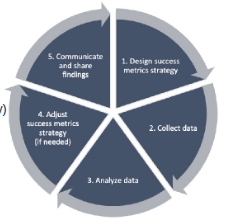
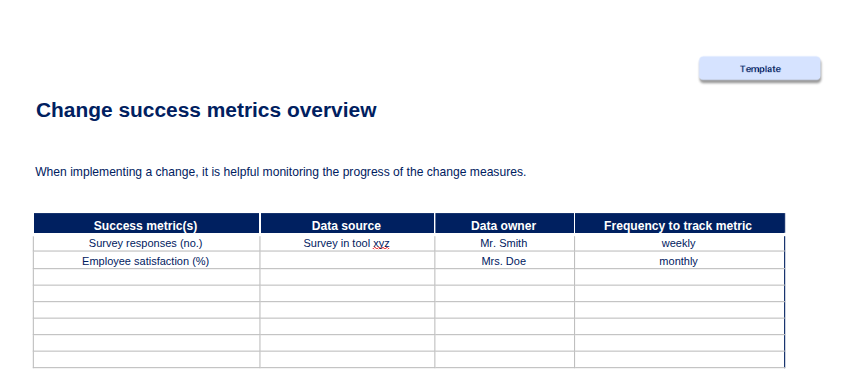

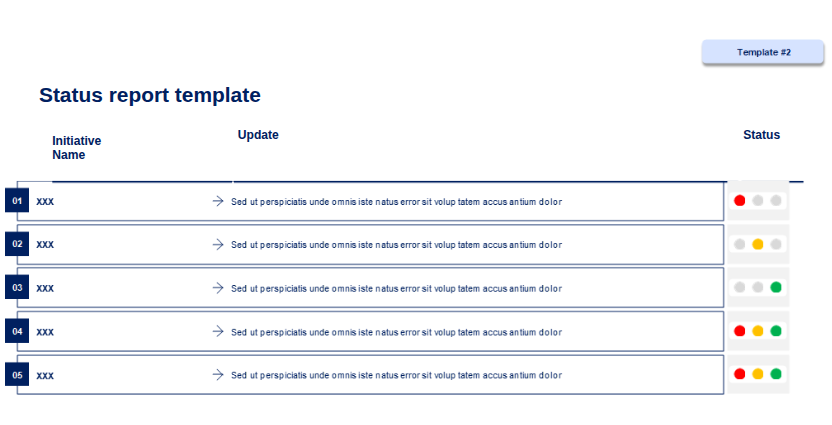
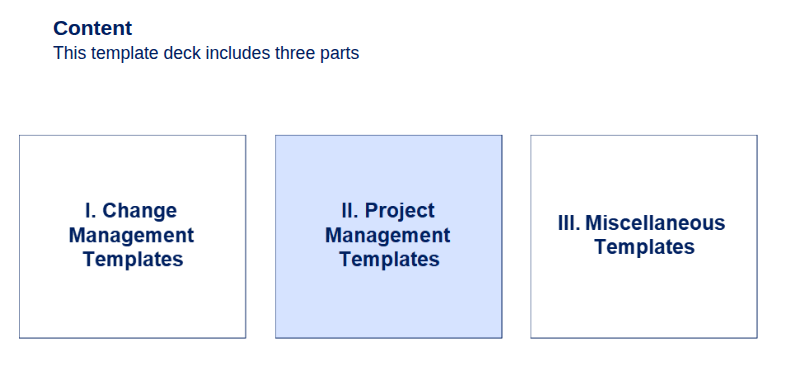
PLEASE NOTE
- Some relevant project management templates are already included in the first section, “Change Management” (e.g., stakeholder map, communication plan).
- For certain project tasks, I recommend not using PowerPoint. For example, in budget planning, please refer to the attached Excel document.
- The following slides contain additional templates that may support you in initiating and planning your project.
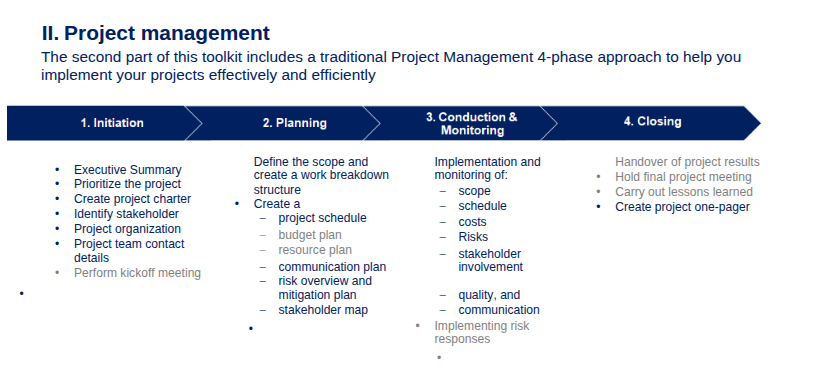
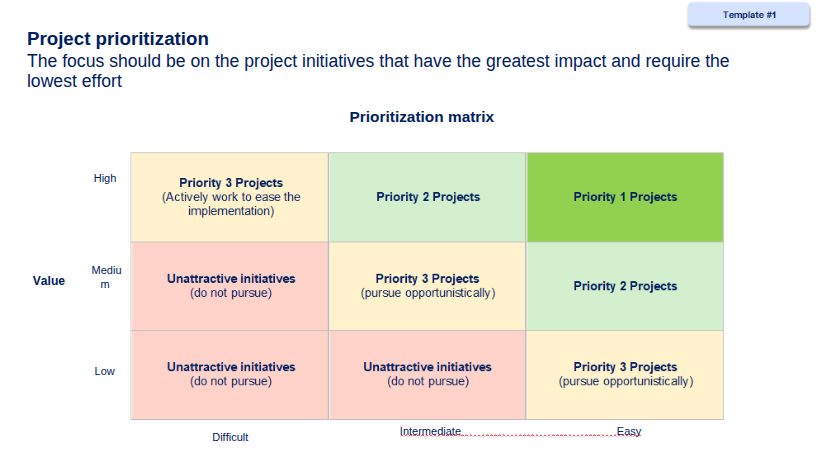
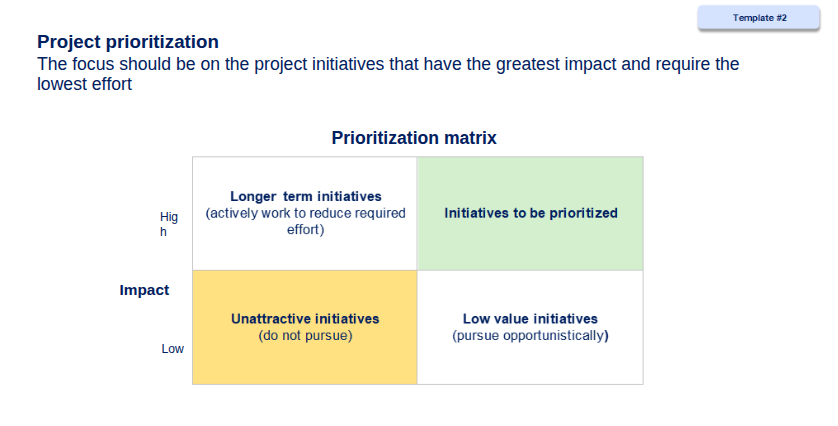
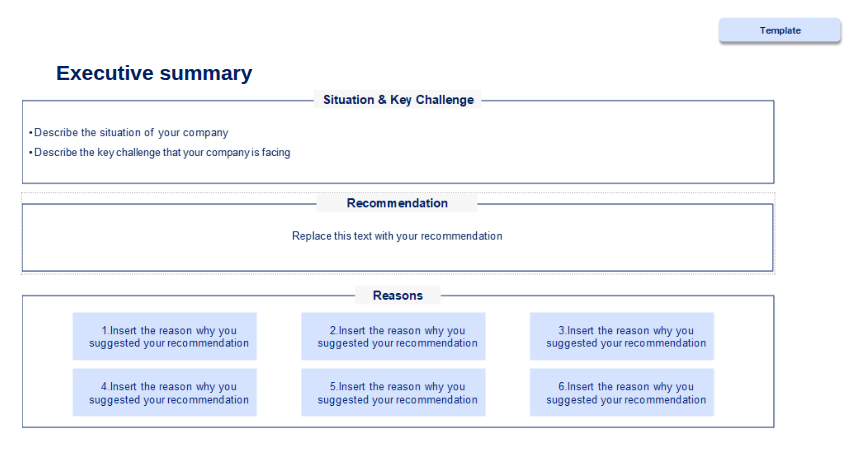
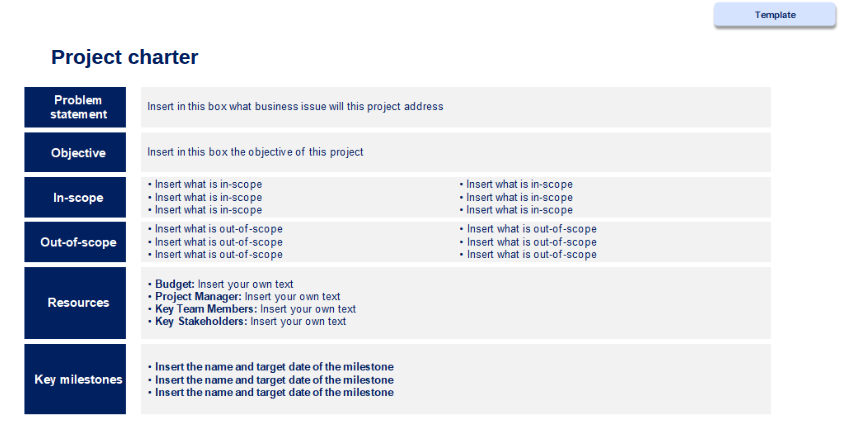
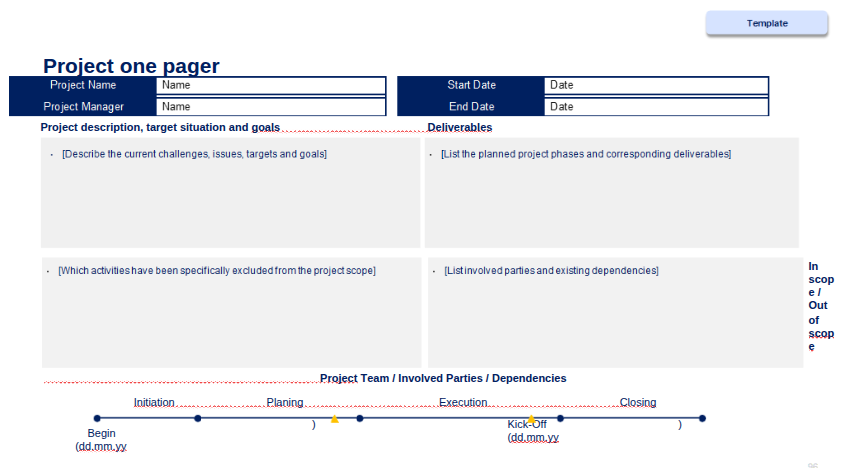

Workstream timeline
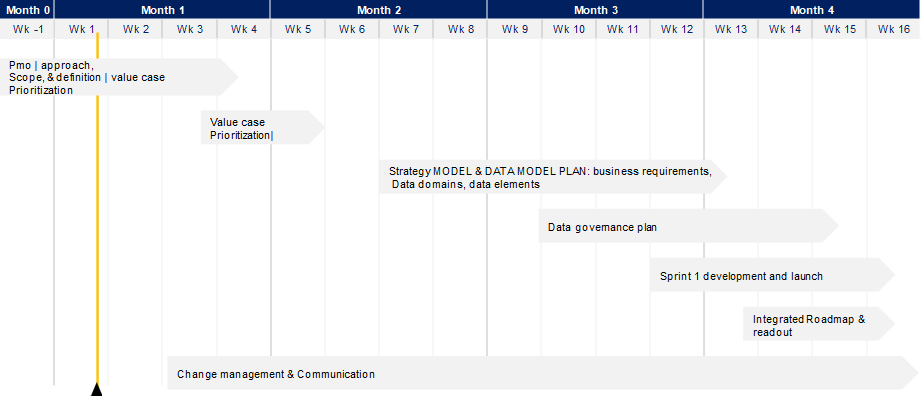

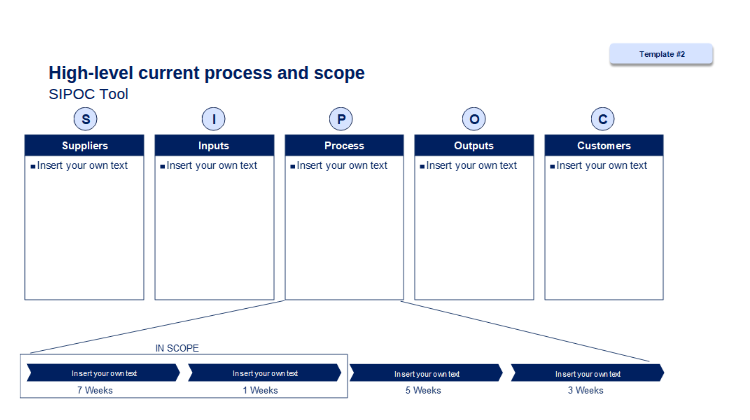
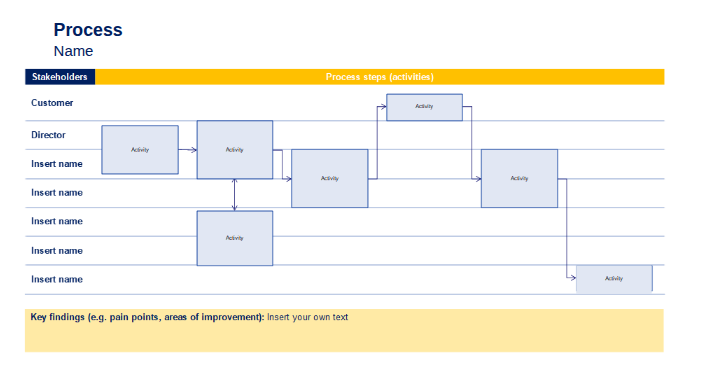
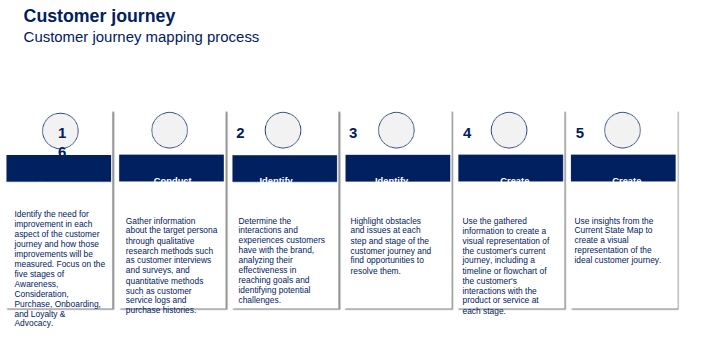
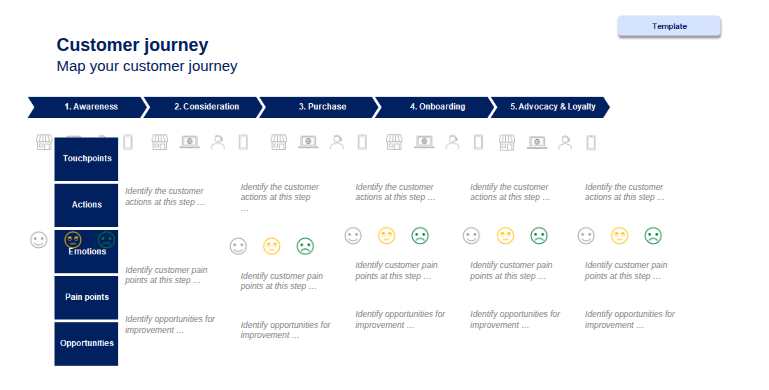
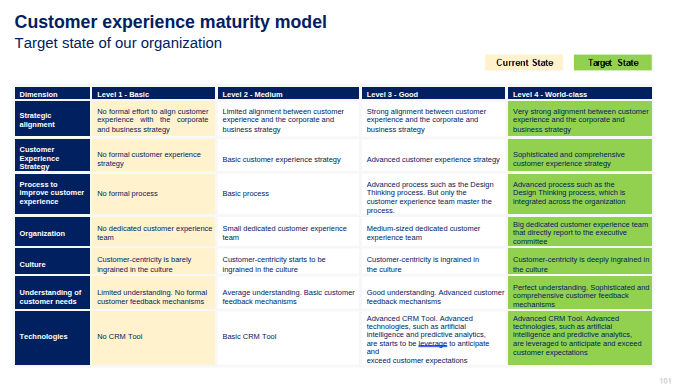
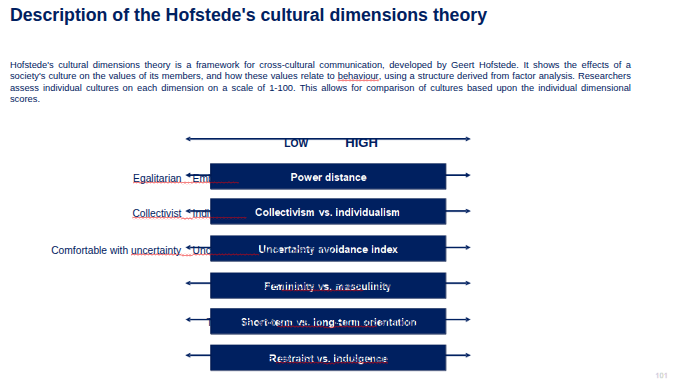
Description of the cultural web diagram
The Cultural Web Diagram is made up of six interrelated elements that make up the model of the work environment:
Stories and myths: These are the past events and people talked about inside and outside the company. They reflect the core values and underlying assumptions of our culture.
- Rituals and routines: These are the daily behavior and actions of people that signal acceptable behavior. This determines what is expected to happen in given situations, and what is valued by management.
- Symbols: These include logos, offices, titles, or even the type of language used, that convey meaning about the organization.
- Organizational structure: This includes both the structure defined by the organization chart, and the unwritten lines of power and influence that indicate whose contributions are most valued.
- Control systems: The ways that the organization is controlled, including financial systems, quality systems, and rewards.
- Power structures: The pockets of real power in the company. This may involve one or two key senior executives, a whole group of executives, or even a department.
By analyzing these elements, you can paint a picture of the shared assumptions and ‘unwritten rules’ that shape the behavior, perceptions, and attitudes within your organization.
You can then compare this picture with the desired culture to identify areas of alignment and misalignment. This gives you a roadmap for cultural transformation, guiding you in changing the elements that don’t align with your vision.
